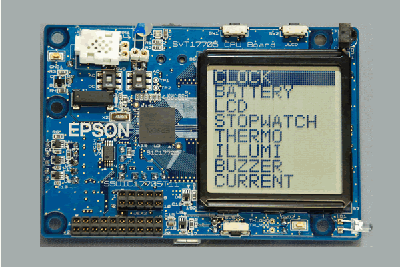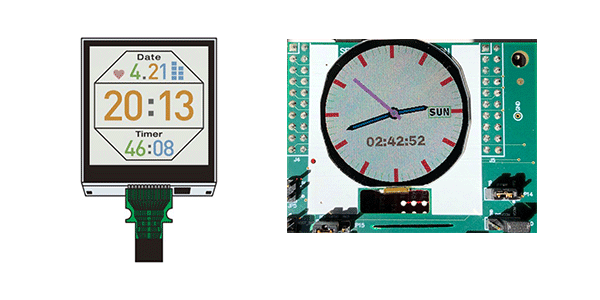What is a Microcontroller (MCU)?
A microcontroller (MCU, short for microcontroller unit) is a type of semiconductor device that integrates a Central Processing Unit (CPU), memory, and various peripheral functions into a single chip. The CPU performs calculations and control operations based on software programs. To support these operations, microcontrollers typically include built-in memory such as ROM for storing programs and RAM for temporarily holding data during processing. In addition to memory, microcontrollers often feature other integrated components such as timers and analog-to-digital converters (ADC). Thanks to their compact and multifunctional design, microcontrollers are widely used in a variety of applications, including home appliances, office automation equipment, and automotive systems.
What are Epson Microcontrollers?
Epson's microcontrollers (MCUs) trace their origins back to the development of digital quartz watches. The early models featured a 4-bit CPU, an oscillator that converted crystal vibrations into a digital clock signal, a dedicated timer that translated the clock into hours, minutes, and seconds, and an LCD driver circuit to display the time on a six-digit screen–all integrated into a single chip. These watch functions were controlled by software programs running on the CPU. The processing capability of a CPU is typically expressed in terms of the data length it can handle at once, measured in bits. Today, CPUs have evolved to 32-bit and beyond, with 32-bit CPUs commonly used in multifunctional smartwatches. It may come as a surprise that such tiny wristwatches contain MCUs. To ensure long-term operation using only a small button battery or solar battery, Epson's MCUs are designed with proprietary ultra-low power consumption technologies, making them ideal for energy-efficient applications.
Overview and Features of Epson's 32-bit Microcontroller Series
Epson's 32-bit microcontrollers are offered under the S1C31 Family product line. These MCUs are built around the Arm® Cortex®-M0+ processor core, which is known as the smallest and most energy-efficient core in the Cortex-M series. It also enables compact code size, making it ideal for resource-constrained applications. By combining this core with Epson's proprietary ultra-low power design technologies, the S1C31 Family delivers outstanding performance in compact battery-powered devices. However, its strengths go beyond low power consumption. The MCUs also integrate Epson's unique peripheral circuits, developed through years of experience with ASSP products and previous microcontroller designs. For example, the LCD driver in the S1C31W series supports up to 2,560 dots (80 segments × 32 commons), offering one of the highest display capabilities in its class of microcontrollers.

Epson's S1C31D01 is the only general-purpose microcontroller on the market equipped with a built-in display controller circuit specifically designed for memory LCDs, which are known for their superior energy efficiency. *1 This model supports 300×300 resolution with 6-bit color (64 colors) and includes advanced graphic functions such as image rotation, scaling (zoom in/out), and transparency adjustment when layering images. These features make it ideal for compact devices that require rich visual interfaces while maintaining ultra-low power consumption.

Among the S1C31 Family, the S1C31D50 series stands out as one of the most unique products. This model features built-in voice and sound playback capabilities, allowing users to create audio content without the need for studio recording, thanks to the Epson voice creation PC tool.
With a newly developed proprietary algorithm, the S1C31D50 enables audio playback not only through standard speakers but also through electromagnetic buzzers and piezoelectric speakers. This makes it possible to integrate voice playback functionality into devices that are smaller and more cost-effective, without compromising on performance.
*1 Based on Epson research as of April 2022.
Overview and Features of Epson's 16-bit Microcontroller Series *2
Epson's 16-bit microcontrollers are offered under the S1C17 Family. While the name might suggest a 17-bit architecture, it is in fact a 16-bit MCU–originally intended to be named the "S1C16 Family," but internal circumstances led to the current naming. The development of the S1C17 Family stems from Epson's original 32-bit microcontroller line, the S1C33 Family *3 (which, incidentally, was also intended to be named "S1C32"). These original MCUs adopt a RISC (Reduced Instruction Set Computer) architecture, enabling low power consumption, compact size, and high functionality–embodying Epson's core design philosophy of "Efficient, Compact, and Precision." The introduction of the S1C33 series led to widespread adoption across a variety of applications. However, some long-time users of Epson's 4-bit and 8-bit MCUs, as well as developers of simpler applications, found 32-bit CPUs to be too high-end for their needs. In response to this feedback, Epson developed the S1C17 Family as a more accessible step-up solution.
| Processor Architecture | Epson-original 16-bit RISC processor |
|
|---|---|---|
| Fabricated using low-power CMOS process technology | ||
| Instruction Set | Fixed 16-bit instruction length | |
| 111 basic instructions (184 total) | ||
Most core instructions execute in a single cycle |
||
| Immediate value extension up to 24 bits | ||
| Memory Space & Bus Architecture | 24-bit address space supporting up to 16 MB of memory | |
| Harvard architecture with separate 16-bit instruction bus and 32-bit data bus | ||
| Interrupt System | Supports reset, NMI, and 32 types of external interrupts |
|
Address misalignment and debug interrupts |
||
| Reads a vector from the vector table and branches directly to the interrupt service routine. | ||
| Software interrupts using vector numbers (all vectors supported) | ||
| Power-Saving Modes | HALT mode (halt instruction) | |
| SLEEP mode (slp instruction) | ||
| Coprocessor Interface | Supports enhanced ALU instructions |
|

Although the S1C17 is a 16-bit CPU, it features eight general-purpose registers and 24-bit special registers, enabling access to a linear 24-bit memory space (up to 16 MB). It adopts a Harvard architecture with separate 16-bit instruction bus and 32-bit data bus, allowing simultaneous instruction fetching and data storage. This architecture enhances the efficiency of pipelined processing, a key advantage of RISC-type CPUs. As a result, the S1C17 can execute one instruction per clock cycle. For example, when operating at a 1 MHz clock, the CPU can theoretically process 1 million instructions per second. *4 While this may sound a bit technical, the bottom line is simple:
The S1C17 CPU is designed to execute programs with high efficiency.
Behind the Development: The Story of Epson's 16-bit MCU
Epson's 16-bit microcontrollers are branded under the S1C17 Family. Naturally, many people ask, "Why not call it the S1C16 Family, since it's a 16-bit MCU?"
Well, which of the following reasons do you think is correct?
- It's not just a 16-bit MCU-we wanted to express that it's a step ahead.
- The name "C16" is already widely used by other companies.
- We followed the success of previous odd-numbered models like the 4-bit S1C63 and the 32-bit S1C33 *3.
- The designer's favorite character in a song happened to be 17 years old.
The truth is... all of the above are correct. With all these thoughts and inspirations behind it, the S1C17 Family was officially released in 2007.
*2 Information as of April 2022
*3 Currently available as a legacy product
*4 Theoretical value; actual performance may vary depending on instruction type and data length
